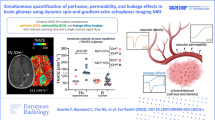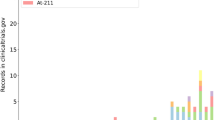Abstract
To present a new compartmental analysis model developed to simultaneously measure tissue perfusion and capillary permeability in a tumor using MRI and a macromolecular contrast medium. Rhadomyosarcomas were implanted subcutaneously in 20 rats and studied by 1.5-T MRI using a fast gradient echo sequence (2D fast SPGR TR/TE/α 13 ms/1.2 ms/60°) after injection of a macromolecular contrast medium. The left ventricle and tumor signal intensities were converted into concentrations and modeled using compartmental analysis, yielding tumor perfusion F, distribution volume Vdistribution, volume transfer constant Ktrans, rate constant of influx kpe, and initial extraction (fraction) E. Tumor perfusion was F=43±29 ml·min−1·100 g−1. The permeability study allowed the measurement of kpe=0.37±0.12 min−1 and Ktrans=0.01±0.0031 min−1. The blood volume could be assimilated to the distribution volume (Vdistribution=2.9±1.01%) since the capillary leakage was small. The simultaneous assessment of perfusion and permeability allowed quantification of the initial extraction (fraction) E=2.34±1.05%. Quantification of both tumor perfusion and capillary leakage is feasible using MRI using a macromolecular blood pool agent. The method should improve tumor characterization.




Similar content being viewed by others
References
Jain RK (1987) Transport of molecules across tumor vasculature. Cancer Metastasis Rev 6:559–593
Brasch R, Turetschek K (2000) MRI characterization of tumors and grading angiogenesis using macromolecular contrast media: status report. Eur J Radiol 34:148–155
Folkman J (1992) The role of angiogenesis in tumor growth. Semin Cancer Biol 3:65–71
Folkman J (1971) Tumor angiogenesis: therapeutic implications. N Engl J Med 285:1182–1186
Hunter GJ, Hamberg LM, Choi N, Jain RK, McCloud T, Fischman AJ (1998) Dynamic T1-weighted magnetic resonance imaging and positron emission tomography in patients with lung cancer: correlating vascular physiology with glucose metabolism. Clin Cancer Res 4:949–955
Buckley DL (2002) Uncertainty in the analysis of tracer kinetics using dynamic contrast-enhanced T1-weighted MRI. Magn Reson Med 47:601–606
Kety SS (1951) The theory and applications of the exchange of inert gas at the lungs and tissues. Pharmacol Rev 3:1–41
Larsson HB, Stubgaard M, Frederiksen JL, Jensen M, Henriksen O, Paulson OB (1990) Quantitation of blood-brain barrier defect by magnetic resonance imaging and gadolinium-DTPA in patients with multiple sclerosis and brain tumors. Magn Reson Med 16:117–131
Tofts PS, Kermode AG (1991) Measurement of the blood-brain barrier permeability and leakage space using dynamic MR imaging. 1. Fundamental concepts. Magn Reson Med 17:357–367
Tofts PS (1997) Modeling tracer kinetics in dynamic Gd-DTPA MR imaging. J Magn Reson Imaging 7:91–101
Fritz-Hansen T, Rostrup E, Sondergaard L, Ring PB, Amtorp O, Larsson HB (1998) Capillary transfer constant of Gd-DTPA in the myocardium at rest and during vasodilation assessed by MRI. Magn Reson Med 40:922–929
St. Lawrence KS, Lee TY (1998) An adiabatic approximation to the tissue homogeneity model for water exchange in the brain. I. Theoretical derivation. J Cereb Blood Flow Metab 18:1365–1377
Antoine E, Pauwels C, Verrelle P, Lascaux V, Poupon MF (1988) In vivo emergence of a highly metastatic tumour cell line from a rat rhabdomyosarcoma after treatment with an alkylating agent. Br J Cancer 57:469–474
Port M, Corot C, Raynal I, Idee JM, Dencausse A, Lancelot E, Meyer E, Bonnemain B, Lautrou J (2001) Physicochemical and biological evaluation of P792, a rapid-clearance blood-pool agent for magnetic resonance imaging. Invest Radiol 36:445–454
Port M, Corot C, Rousseaux O, Raynal I, Devoldere L, Idee JM, Dencausse A, Le Greneur S, Simonot C, Meyer D (2001) P792: a rapid clearance blood pool agent for magnetic resonance imaging: preliminary results. MAGMA 12:121–127
Bottomley PA, Foster TH, Argersinger RE, Pfeifer LM (1984) A review of normal tissue hydrogen NMR relaxation times and relaxation mechanisms from 1–100 MHz: dependence on tissue type, NMR frequency, temperature, species, excision, and age. Med Phys 11:425–448
Hittmair K, Gomiscek G, Langenberger K, Recht M, Imhof H, Kramer J (1994) Method for the quantitative assessment of contrast agent uptake in dynamic contrast-enhanced MRI. Magn Reson Med 31:567–571
Tardivon A, Guinebretiere JM, Dromain C, Caillet H (2002) MR imaging of breast cancer with a new macocyclic blood pool agent (P792). Eur Radiol 12(Suppl 1):158
Brix G, Bahner ML, Hoffmann U, Horvath A, Schreiber W (1999) Regional blood flow, capillary permeability, and compartmental volumes: measurement with dynamic CT-initial experience. Radiology 210:269–276
Turetschek K, Floyd E, Shames DM, Roberts TP, Preda A, Novikov V, Corot C, Carter WO, Brasch RC (2001) Assessment of a rapid clearance blood pool MR contrast medium (P792) for assays of microvascular characteristics in experimental breast tumors with correlations to histopathology. Magn Reson Med 45:880–886
Daldrup HE, Shames DM, Husseini W, Wendland MF, Okuhata Y, Brasch RC (1998) Quantification of the extraction fraction for gadopentetate across breast cancer capillaries. Magn Reson Med 40:537–543
Daldrup H, Shames DM, Wendland M, Okuhata Y, Link TM, Rosenau W, Lu Y, Brasch RC (1998) Correlation of dynamic contrast-enhanced magnetic resonance imaging with histologic tumor grade: comparison of macromolecular and small-molecular contrast media. Pediatr Radiol 28:67–78
Daldrup-Link HE, Brasch RC (2003) Macromolecular contrast agents for MR mammography: current status. Eur Radiol 13:354–365
Torlakovic G, Grover VK, Torlakovic E (2005) Easy method of assessing volume of prostate adenocarcinoma from estimated tumor area: using prostate tissue density to bridge gap between percentage involvement and tumor volume. Croat Med J 46:423–428
DiResta GR, Lee JB, Arbit E (1991) Measurement of brain tissue specific gravity using pycnometry. J Neurosci Methods 39:245–251
Pradel C, Siauve N, Bruneteau G, Clement O, de Bazelaire C, Frouin F, Wedge SR, Tessier JL, Robert PH, Frija G, Cuenod CA (2003) Reduced capillary perfusion and permeability in human tumour xenografts treated with the VEGF signalling inhibitor ZD4190: an in vivo assessment using dynamic MR imaging and macromolecular contrast media. Magn Reson Imaging 21:845–851
Renkin E (1959) Transport of potassium-42 from blood to tissue in isolated mammalian skeletal muscles. Am J Physiol 197:1205–1210
Crone C (1963) The permeability of capillaries in various organs determined by the use of the “indicator diffusion” method. Acta Physiol Scand 58:292–305
Acknowledgements
We wish to acknowledge Dr. Marie France Poupon (Institut Curie, Paris, France) for providing us with the S4MH cell lines. Work supported in part by the William D. Coolidge grant of the European Congress of Radiology (C.A.C.).
Author information
Authors and Affiliations
Corresponding author
Appendix
Appendix
The blood flow (F), the fractional plasma volume (νp), the volume transfer constant (Ktrans), the influx rate constant (kpe), and the extraction fraction (E) were deduced from k2,1, k3,2, and k0,2, using Fick’s general equation of mass balance, which applied to the open two-compartmental model describes the transport of a contrast medium through the plasma compartment and its leakage into the interstitial space [19]:
Equation (8) can also be written as:
where Vvoxel is the volume of a voxel. Using the tissue density of the voxel (ρ=M/V) Eq. (9) becomes:
By analogy with Eq. (6) of the model, Eq. (10) can be written:
Cv(t), the concentration in venous plasma at the exit of the capillary, is assumed to be equal to the concentration in capillary plasma Cp(t) giving:
All parameters were obtained by analogy between Eq. (6) (derived from our compartmental model used with SAAM II) and Eq. (12) (derived from general equation of mass balance) separating the flow and the permeability components:
For flow, the analogy of the amount of CM received by the capillary compartment yields:
In other words, in Eq. (13), the left side (derived from the general equation of mass balance) is considered equivalent to the right side (derived from our imaging compartmental model).
In MRI the extracellular CM concentration is measured in the whole blood volume (Cb). Therefore a correction of Cb by the hematocrit (Ht approx. 0.45) is necessary:
Using Eq. (14), Eq. (13) becomes:
The product F×ρ×Ca(t) is equivalent to the product k2,1×Cb(t)/(1-Ht). Therefore estimation of k2,1 from experimental data [Cb(t)] allows deduction of volume blood flow:
The tissue density (ρ) is assumed to be equal to 1 according to literature values [24, 25].
For permeability, the analogy of exchanges between compartments yields:
Replacing qp by νp×Cp(t)×Vvoxel, Eq. (17) can be simplified into:
When using a macromolecular CM with a low leakage rate, we can assume that the concentration in the extravascular extracellular space is negligible in comparison with the concentration in the capillary at the beginning of the experiment. The rate constant kpe is deduced from:
P×S×ρ is equal to Ktrans, and the ratio Ktrans/νp is equal to kpe(t).
For blood volume, the analogy of the venous output yields:
Replacing qp(t) by νp×Cp(t)×Vvoxel Eq. (20) can be simplified into:
The plasma volume νp is deduced as follows:
The extraction fraction E is calculated according to the model of Renkin [27] and Crone [28] of capillary permeability such as:
Rights and permissions
About this article
Cite this article
de Bazelaire, C., Siauve, N., Fournier, L. et al. Comprehensive model for simultaneous MRI determination of perfusion and permeability using a blood-pool agent in rats rhabdomyosarcoma. Eur Radiol 15, 2497–2505 (2005). https://doi.org/10.1007/s00330-005-2873-z
Received:
Revised:
Accepted:
Published:
Issue Date:
DOI: https://doi.org/10.1007/s00330-005-2873-z




